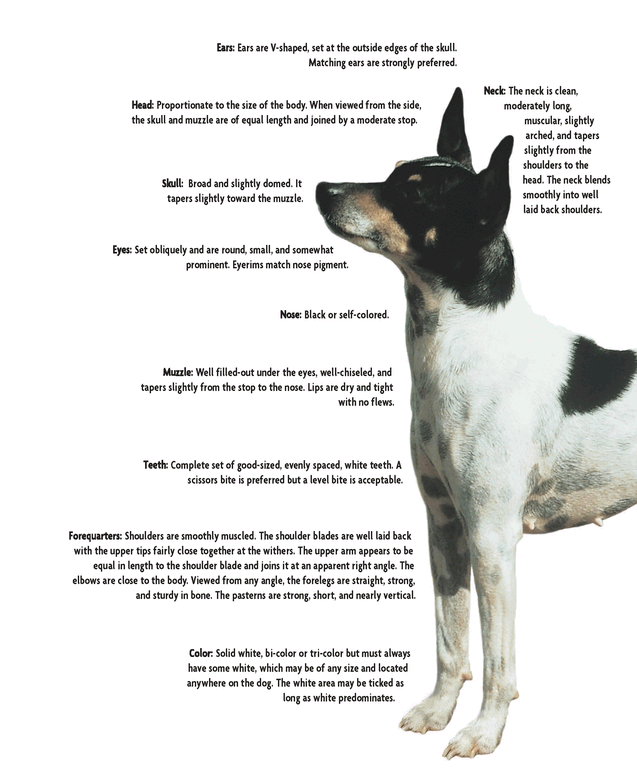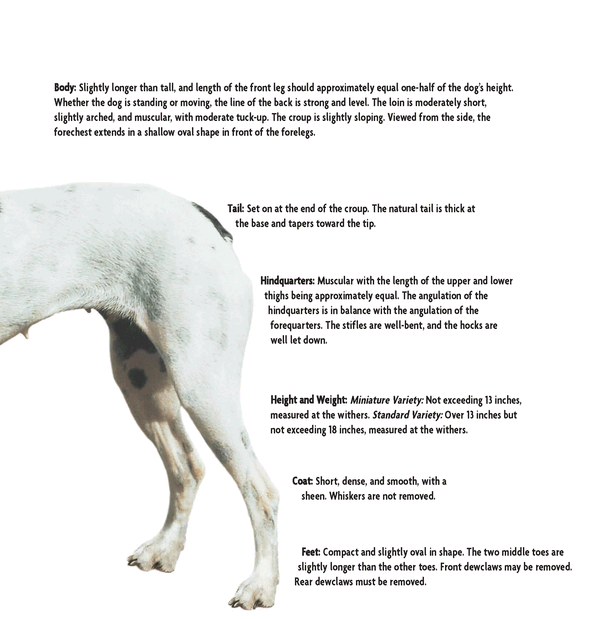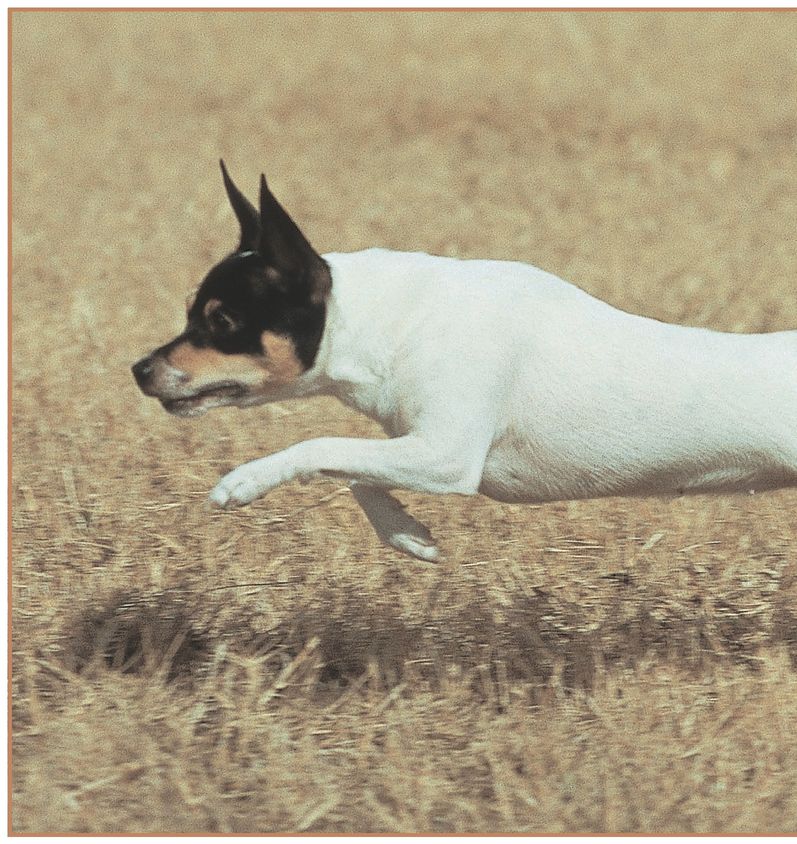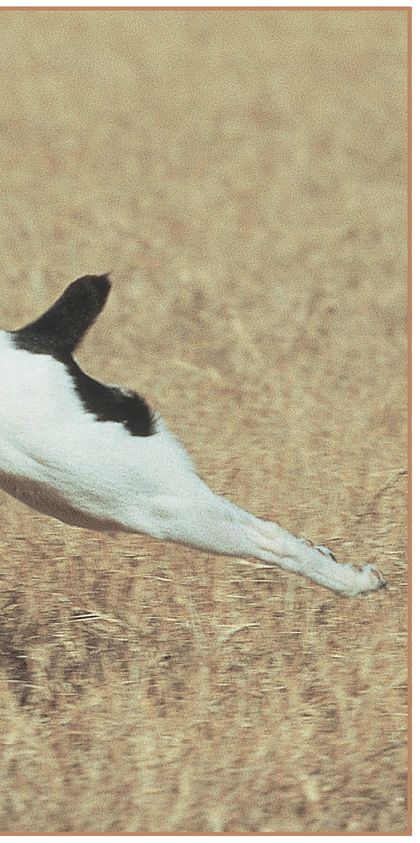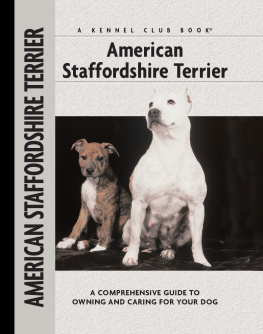Table of Contents
Physical Characteristics of the Rat Terrier
(from the United Kennel Clubs breed standard)
The Rat Terrier is a very active, healthy dog that requires any equally on-histoes owner to keep pace with this dynamic companion dog.
HISTORY OF THERAT TERRIER
The feisty terrier! An expression heard so often in terrier talk, one might believe it was the name of an actual breed! But, down through the ages, only one terrier officially had the boldness and tenacity to claim the name as its own. The distinctive Feist originated in England in the 1820s. But even in England, his beginnings were more reflective of Americas melting pot, the country in which he later was developed as a distinct pure breed. Like the Americans who embraced him, his colorful ancestry was a bit of this and that. Historians say that he was a cross of the Smooth Fox Terrier and the black and tan Manchester Terrier. But they go back even further to those oldest breeds that comprise these two breeds and gave the Feist its uniqueness: the English White Terrier, now extinct, adding mild manner, gentility and nobility; the Black and Tan Terrier, adding hearty demeanor and keen senses; the Bull-and-Terrier, supplying feistiness, tenacity and stamina; and the Hinks White Bull Terrier, creating true grit and gameness. The resultant new breed had coloring like the Manchester, black body and face with tan trim on his cheeks and tan spots over the eyes. Demonstrating fearless tenacity, this hybrid became known as a Feista perfect title for this small, smart, hardy varmint dispatcher!
DOCKING THE TAX
Over 200 years ago, English laws came into effect stating that dogs that worked for a living were exempt from tax. Working dogs were distinguished by the docking of the tail. The practice of tail docking on Rat Terriers has always been done to prevent risk of injury as they work.
EAR CROPPING
Ear cropping consists of surgically trimming the ear leathers and then training the ears to stand upright. The Rat Terriers ears are never cropped. Originally, cropping was done to prevent the ears from being bitten by any adversary. With fighting dogs and terriers, cropped ears gave the opponent less to hang on to. Ear cropping also was considered important for cosmetic purposes, as it gives the dog a very smart look. In the US, dogs can be shown with cropped or natural ears, as is the case in most European nations. American breeders concentrate on the stylish look of cropped ears, which they believe give the dogs head a more appealing, sharper look. In fact, at most shows in the US, it is more difficult to do top winning with a dog with natural ears, though some pet owners favor the natural look.
The breed won British fanciers almost immediately. This was a versatile dog, resourceful and determined, with a generous nature. Master of the hunt in the fields, the Feist also caught the eye of those in the less scrupulous sport of rat baiting. At that time, terriers were often pitted against other terriers, but the Feists natural instinct to kill vermin created a new sport. The dog was placed in a pit and hundreds of rats were poured down. Bets were wagered as to how many vermin the Feist could dispatch within a specified time. As ratting competitions became the favorite social events of royalty and commoners alike, many fell in love with this small terrier. But perhaps most captivated were the many American visitors who had never seen such a dog. The first Feists, or ratting terriers, in the US appeared during the 1850s and 60s, but the vast majority of imports arrived in the 1890s. Old Englands favorite ratter was about to become a truly American breed.
By the turn of the 19th century, the United States was outgrowing its adolescence. Frontier living was giving way to civilized society and even country dwellers were no longer protecting their homes from bear! Hunters who had previously used bulldogs and curs for protection and guard now desired a dog that could trail and tree small game. The first Rat Terriers (Feists) were exclusively black and tan colored, ears buttoned over, mediumsized and approximately 18 pounds. Gaining popularity in the southern parts of the US, these imports easily adapted to different climates and terrain. They kept farms free of rats and fox and proved to be excellent hunters. From squirrels to cougar, they were quick, fierce and lethal.
But American Rat Terrier enthusiasts saw room for improvement and for the next 30 years, the Feist would be bred based primarily on function. Form would be a product of its purpose and development. The breed, in fact, underwent a process that would take it far from its original form in England.
ABOUT 357 RATS PER HOUR
The Rat Terrier is astounding in his ratting abilities and the breed came to be known as the prince of the rat pits. Developed in Great Britain to be quick and fierce in the hunt, one ratting terrier named Billy was believed to have killed 2,501 rats in 7 hours in Suffolk!
Breeds were added to the Rat Terrier dependent on geography and required purpose of the dog. Those seeking a good hunting dog with more desire to be a companion brought about the reintroduction of the Smooth Fox Terrier, turning the breed into the black and white tricolored dog we see today. To further enhance his hunting prowess, he was crossed to the Beagle with its topnotch scenting ability. A stockier body and shortened legs were also favored for going to ground. With the addition of the Whippet and the Greyhound, breeders got a speedier hunter with better sighting ability and a slightly elongated body. They also added a wonderful range of new colors: red, liver, chocolate, brindle, black fawn and cream. But perhaps most important, these gentle breeds produced a mellower Feist, the temperament we see in todays Rat Terriers. Over time, the Chihuahua, Toy Fox Terrier and Toy Manchester were introduced to bring down the size considerably, accounting for the toy variety commonly seen today and also for new colors. These three toy breeds are, in fact, considered among the most influential of the breeds added to the makeup of the Rat Terrier. The new improved breed was indeed a winner! The Rat Terrier was a hunter with a 100-yard rangehunters could follow on foot while he trailed and treed small game; he was a watchdog with keen sight and smell; and, finally, he was what his breeders and fans fervently pursueda devoted and generous companion dog.
THE TOY FOX COMPARISON
Given the many shapes and sizes of the Rat Terrier over its history in the US, the breed has often been confused with other breeds like the Jack Russell Terrier (which is not as refined as the Rat Terrier) and the Toy Fox Terrier. This latter breed is indeed similar in some respects, but different in many others. The Toy Fox Terrier never weighs over 7 pounds, while the giant Rat Terrier can weigh as much as 35 pounds; albeit the toy variety can weigh a mere 4 to 6 pounds. The outline of the Toy Fox is squarer than the longer body of the Rat Terrier, and the topline slopes slightly, which is not a characteristic of the straight back of the Toy Fox. There are also differences in the eyes and ears of the two breeds. The Rat Terrier has V-shaped ears that can be erect, tipped or button, while the Toy Fox are always erect and set more to the sides. The eyes are more obliquely set in the Rat Terrier, compared to the forward placed eyes of the Toy Fox.


